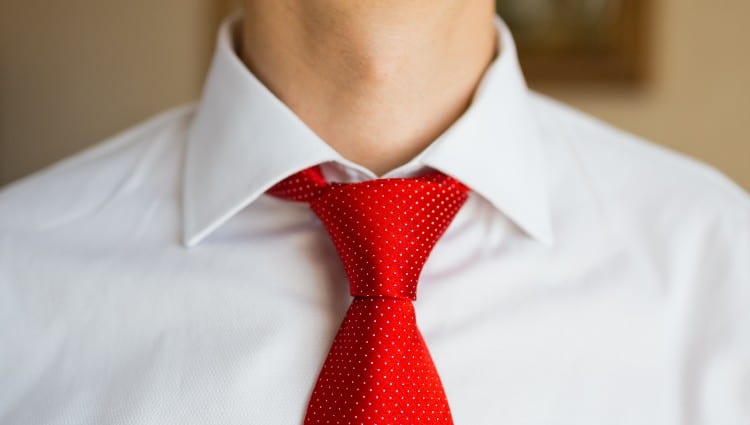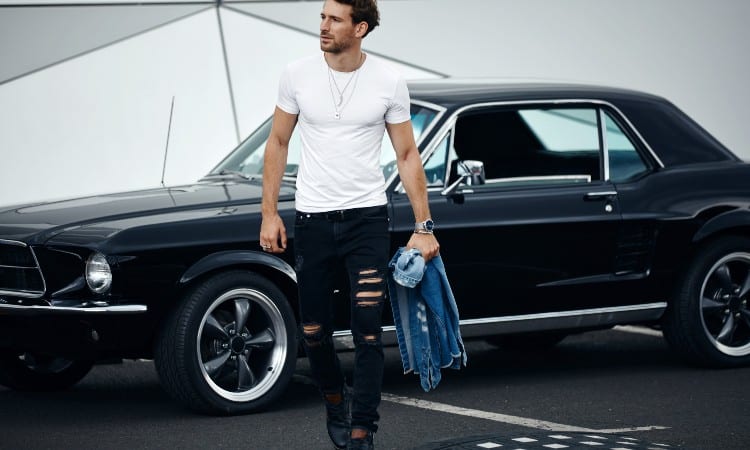When you need to buy a new t-shirt or button-down these days, you have to decide what size works best for you and what cut or style will suit your body type. These styles vary from brand to brand, making it tricky to find out what type of shirt fits you best. On top of that, constantly changing fashion trends make it hard to know how a shirt should fit, to begin with!
A dress shirt or t-shirt should fit snuggly across the shoulders and chest but should not strain the fabric. For men and women, current fashion trends prefer fitted dress shirts and t-shirts when possible. This style features curved seams or shaping elements that create a concave waist.
In this article, you will learn six guidelines for choosing a fitted shirt. You will find tips on how to find a good button-down or t-shirt for both men and women. Finally, you will discover a guide for how to tuck in a too-long shirt.

How Can You Tell if Your Shirt Fits or Not?
Modern fashion dictates that a shirt should hug your form without straining at the seams and closures. Of course, body type, constantly changing fashion trends, and even age can also impact what looks like a correctly fitted shirt!
Here’s the thing: in many ways, what the average well-dressed person views as a good fit will change from year to year and definitely from decade to decade. Think of the way business professionals dressed in the 1980s. Everyone wore boxy suits and rectangular-shaped tops. Women even wore shoulder pads to add to the boxy, rectangular silhouette!
Today, the style tends toward as little excess fabric as possible. Button-down shirts come in a variety of modern cuts, including fitted, muscle cut, and slim-fit. These all shape the shirt so that it curves at the waist and has narrow shoulders.
That said, you know your body best. In some cases, a fitted shirt might highlight features you prefer to mask; if you have a super-broad shoulder, you might not want to display a narrow waist, for example! In these cases, you should select a cut that creates the body shape you want.
Age also plays a role in style choices. In many cases, different generations follow different fashion trends simultaneously! Some types of shirts, such as t-shirts, tend to transcend age barriers and achieve mass appeal, though.
One final challenge makes defining a good fit of a shirt quite tricky. While t-shirts have more or less universal cuts and styles, such as a women’s cut, a slim fit, or a muscle cut, every brand selling dress shirts offers its own variation of styles. This means that a slim-fit cut from one brand may fit you quite differently from a slim fit produced by another brand!
Based on the current best-selling brands and popular fashion, you can know that the style today promotes close-fitting shirts. Some stylists suggest that you should wear a button-down or tee that fits as tightly as possible without making you uncomfortable or unable to move!
How Should a Shirt Fit: Six Guidelines
Every brand and style of shirt has a slightly different fit, but in general, you can follow basic guidelines for the fit of the neck, sleeves, shoulders, torso, stomach, and length of the shirt to get a good fit.
1. Neck

The collar of your button-down should button shut and still allow you to place two fingers inside it comfortably. For t-shirts, the neck opening will generally follow these rules, though some tees have V-necks or other collar styles that will change things up.
For men’s shirts, collar sizes usually range from 15 inches to 17.5 inches. This measurement spans the inside edge of the collar in a straight line, from the button to the buttonhole on the opposite end of the collar.
For women, the two-finger rule usually holds true for button-downs. On tees and other kinds of shirts, women’s necklines can have a wide variation of collar types, including V-necked, plunging scoop necklines, boat necklines, and so on.
2. Sleeves
Sleeve styles do change a lot as fashion trends develop, but right now, sleeves tend toward a fitted, tapered style. This gives your arms a long and lean look without any puffy fabric flapping around like a pirate on a romance novel cover.
This type of sleeve can feel constricting, so you may want to try out a couple of different cuts from a brand you like to see if you can find sleeves that look fitted but don’t restrict your movement.
Another part of sleeve style depends on the armhole. Fitted or slim-fit button-downs often have high, small armholes that help pull the sleeve and shoulder taunt. A bigger armhole feels more roomy and comfortable but often leads to excess fabric in the body of the sleeve.
Most stylists recommend a sleeve length that has the hem of the cuff reaching to the bottom of your thumb. You may want to mix this up a bit depending on whether or not you plan to pair the button-down with a suit jacket, blazer, or cardigan, though!
3. Shoulders
The shoulder seam on a tee or buttondown should rest at the outer edge of your shoulder. This creates a sleek line from the neck down your arm, rather than a baggy or puffy look if the shoulder seam falls part of the way down your arm. On the opposite end of the spectrum, you also don’t want the shoulder seam lying partway between your shoulder and neck, as this means the shirt is too small for you.
Finding a shirt that fits the width of your shoulders with precision may seem difficult if you purchase ready-wear clothing. Most clothing manufacturers attempt to make one-size-fits-all clothes that (of course) do not fit anyone perfectly!
If you can’t afford to buy made-for-you bespoke clothing, you could take your clothes to a tailor and have a few small modifications made for a reasonable price to get that fitted look down to a T.
If you don’t want to spend that extra money, you could also shop around at different brands and try the cuts they offer, such as fitted or slim fit. You may find one that suits your body type best and gives you a clean shoulder line.
4. Torso
You want a fitted tee or button-down to indicate the shape of your chest without stretching so tightly over your skin that the fabric wrinkles or strains. If you see any gaps in the buttons or horizontal wrinkles across the torso, you need a bigger size!
Men’s and women’s shirts look quite different in the torso. Women’s button-downs often incorporate small shaping darts to give the shirt an hourglass shape. Women’s tees often have concave sideseams that give the tee more of a shape.
However, no matter your gender, you can test the fit of a shirt at the torso by pinching a bit of fabric at the center of your chest and pulling on it. Does the pinched fabric easily lift away from your body with one to three inches of excess fabric? This usually indicates a good fit.
5. Stomach
For a perfectly fitted shirt, you want the lower torso or the stomach area to nip in at the waist and fit snuggly across the front and back.
This part of the fitted shirt structure often presents some trouble for anyone who does not have a perfectly flat stomach, though! This happens because modern shirts for men and women tend to have tapered waists that narrow from the chest to the waist or stomach area.
You do not want to have a shirt that looks great on your shoulders and chest but snugs too tightly across your stomach. Plus, if the shirt strains across your stomach, it may not hang down low enough at the hem, which could lead to an unfortunate stomach sighting at an inopportune moment!
In this case, you may want to find a different cut or style from a brand you like. If the slim fit style left you feeling pinched around the middle, you might want to try a muscle or athletic cut, or perhaps a modern or even classic fit.
6. Length
The hem on a button-down should reach just to the top of the back pocket, allowing you to easily wear the shirt tucked in or untucked. The same principle holds true for tees because you do not want a super-long tee to make you look short!
You can judge the correct length of a button-down or t-shirt by tucking it into the waistband of your pants and raising your arms. If the hem comes out of the waistband at this motion, you probably need a longer shirt.
For women, the same length concept applies, but the hourglass shape of most women’s cut tees and button-downs can make it a little trickier to discern the correct fall of the hem. If possible, try on a shirt, tuck it in, and perform the arm-raising test to ensure you have a long enough hem.
How a Dress Shirt Should Fit a Man
A man’s dress shirt should fit closely around the torso and stomach, have slim, tapered sleeves, and hang to a couple of inches below the beltline. The key concept with a slim-fit or modern button-down is that you want it to indicate the shape of your chest, shoulders, and arms without actually stretching across your skin.
If you see any fabric puffing out at the waist, shoulders, elbows, or cuffs, you have found a too-large shirt and need something smaller. Likewise, if you notice stretch wrinkles in any area or gaps at the buttons, you have found a too-small shirt and need a larger size.
Keep in mind that these rules illustrate how a slim, slim-fit, or modern cut button-down should fit. Plenty of popular brands still sell a regular or classic cut in men’s dress shirts as well.
These styles do still incorporate some excess fabric. This does not match current trends, but a baggier style might make you feel more comfortable!
How a Shirt Should Fit a Woman
Women’s button-down shirts should fit closely for a modern, sleek look. Women’s shirts follow the six basic guidelines described earlier, with a few additional areas to consider as well.
First, many women have trouble finding a top that fits snuggly without straining at the bust area. If possible, try on clothing before making a purchase and make sure you don’t see any buttonhole gaps. Many clothing manufacturers also provide sizing charts that will list a bust measurement, so you can make sure the tee or button-down will fit in this area even if you can’t try it on!
It does not matter if a size 12 fits you in one brand because another brand may use completely different sizing. Instead of depending on US or European sizes, always look for the specific measurements in the sizing chart.
Another area of concern is the hips. Fitted shirts for women often have curved sideseams that swoop in at the waist and then back out at the hips. But women with wider hips may still find this area too narrow. In this case, the shirt will feel tight and ride up towards your waist as you walk.
How a T-Shirt Should Fit a Man

A t-shirt should fit a man closely across the torso, present a defined waist, and end two inches below the beltline.
Current fashion does allow looser tees than button-downs, so you should always find it possible to pinch two to three inches of loose fabric at the torso and waist of your tee. You also do not want the collar or sleeves to feel like they could cut off the blood flow in your neck or arms!
Some t-shirts sellers and popular brands do offer variations on the classic rectangle shape of the regular tee. These include a muscle cut that allows extra space in the torso or a slim-fit cut with a tapered waist for the person with a thin body type.
You also want to consider your body type and pick a tee for your body type that looks good on you and makes you feel comfortable. This may mean selecting a slim-fit cut in a larger size than you used to wear to accommodate a differently sized waist than you had a few years ago. Or it might mean choosing a regular-cut tee instead of a slim-fit if the regular cut feels better on you!
How a T-Shirt Should Fit a Woman

Women’s t-shirts typically come in a different shape than a rectangular unisex or men’s tee. The curving side seams and smaller sleeves in many women’s t-shirt styles allow the tee to conform to the hourglass-like shape of most women’s bodies.
That said, the general concept that you want the tee to hug your body without stretching revealingly tight holds true. You will also want to watch out for the hemline on fitted women’s tees, as a larger than average bust or hips could cause the hem to rise too high.
Is a women’s medium t-shirt the same as a men’s small? Nope! Most t-shirt brands sell tees for men and women that have very different cuts.
This means that no matter the size, the men’s and women’s tees will never exactly match each other.
Where Should Shoulder Seam Fall?

For both men’s and women’s shirts, the shoulder seam should fall at the edge of your shoulder. However, you do not want the seam to fall over onto your upper arm. You also do not want the seam to creep up onto your shoulder, as this indicates a too-small fit and will look pinched and uncomfortable.
Getting the shoulder seam in the right place will make your sleeves fit right and allow your collar to lie right, too! For this reason, you shouldn’t shrug off an ill-fitting shoulder seam. Either find a different brand that fits your body type better, or consider taking your clothes to a tailor for an alteration.
How Long Should a Shirt Be?
Shirt length does vary based on the type of shirt, but in general, the hem should fall about two inches below your beltline or just to the top of the back pockets in your pants.
This length covers your stomach and allows for easy tucking in. It also will not hang clumsily if you want to leave the shirt untucked!
A too-long shirt will make you look short, as it covers up more of your upper body and hips. A too-short shirt will not tuck in easily and can lead to very unstylish stomach or lower back reveals.
If you have a long or short torso, find a brand of shirt that fits your body! This way, you can match the current hem style that falls a couple of inches past the top of your pants, no matter what size or shape you are.
How to Tuck in a Shirt So It Fits You
You can tuck in a shirt, so it looks like it fits you even if the waist is too large! To do this, you just need to master a simple technique called the military tuck. This will work on any top you plan to wear tucked in for both men and women!
Like most people, you probably buy ready-to-wear clothing that manufacturers make for average body types. Clothing lines often skew things to the larger end of sizes to make the clothing accommodate more people. This means you may find a shirt that fits you everywhere except the waist.
If you have a nice shirt that bags at the waist, try this:
- First, tuck in the back and sides. Pull this firmly so that no excess material gets tucked into the back section. This will leave you with some excess material at the front of the shirt.
- Now pinch the extra fabric at each side seam. Pull the front of the shirt taut but not so much that the fabric stretches or wrinkles.
- Finally, fold over the pinched material as if you are making a pleat in the fabric. You should have a flat fold that tucks neatly into the waistband and no extra fabric puffing out at the waist anywhere!
How Do You Tell if a Shirt Will Fit Without Trying It On?
Knowing your measurements is the best way to tell if a shirt will fit without trying it on. In the world of online shopping, trying on a new brand often isn’t an option. Instead, you can learn how to take your own measurements and compare your numbers to the sizing chart provided in the product description for most online clothing sales.
You can also get familiar with the way various sizes fit you in each brand you like. For instance, if you know a size 8 Calvin Klein button-down fits your shoulders, you can expect another size 8 Calvin Klein button-down to fit your shoulders, too!
Of course, a size 8 shirt in another brand may have completely different measurements. For this reason, you may want to consider keeping track of what brands and sizes you have tried. This way, you can easily return to the size and brand that fits you next time you go shopping!
Finally, you can always take the easy way out by buying shirts made out of more stretchy material. This gives you a bit of wiggle room if the shirt does not fit perfectly!
Conclusion
Today’s shirt styles favor a closely fitting button-down and t-shirt for both men and women. These shirts often have tapered sleeves and waists and lie snuggly across the chest and shoulders.
A shirt with a good fit should not stretch uncomfortably tight across the skin or display button gaps. That said, a well-fitted shirt will not include any excess fabric that poofs or puffs out of the sleeves or waistband, either.
What is your most helpful tip for buying a well-fitted shirt? Leave a comment below to let us know!